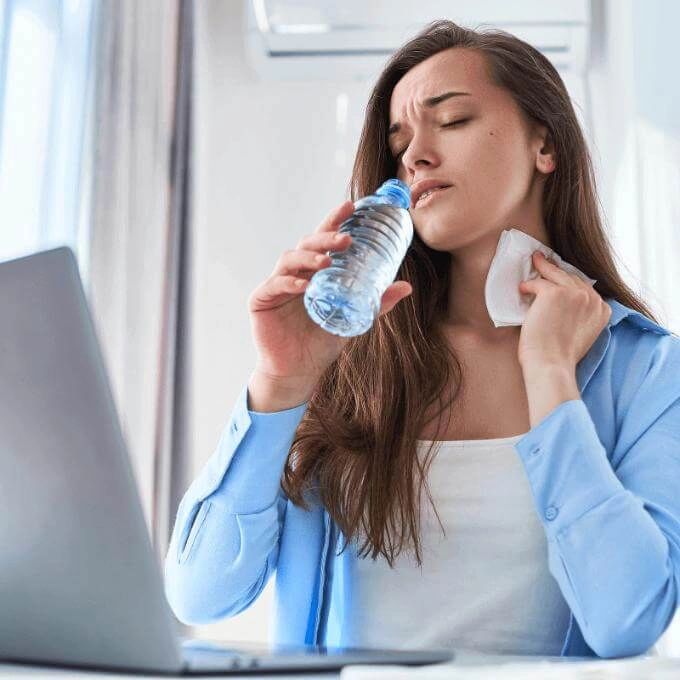Home/Wellness Zone/Sakra Blogs
28th Apr, 2022

Heatstroke also known as sunstroke, is a serious and life-threatening condition and must be considered an emergency. It generally occurs when the body is unable to rid itself of excess heat due to vigorous activity such as working, exercising, or just sitting in a hot environment.
If left untreated, it can kill or cause damage to the brain or other major organs of your body. The longer it is left, the more severe heat stroke can become. In some cases, it can be serious.
Though anyone can get heatstroke, some people are more susceptible including children, athletes, alcoholics, diabetics and those not used to intense heat and sun. Certain drugs can also make a person more prone to heatstroke. It is more common in people over age 50. It often happens as a progression from milder heat-related disorders such as heat syncope (fainting), heat cramps and heat exhaustion. But it can strike even if you have no signs of previous heat injury.
Heat Stroke Symptoms
The main sign of sunstroke is a markedly elevated body temperature (> than 104° F) with changes in mental status ranging from personality changes to confusion and coma. The skin may be hot and dry — although if sunstroke is caused by exertion, the skin may be moist.
Other heatstroke symptoms may include:
Rapid heartbeat/pulse
Rapid and shallow breathing
Irritability, confusion or unconsciousness
Elevated or lowered blood pressure
Stoppage of sweating
Feeling dizzy or lightheaded
Headache
Nausea (Vomiting)
Fainting, which may be the initial symptom in older adults
If sunstroke progresses, the following serious symptoms can develop:
Mental confusion
Hyperventilation
Body cramps
Painful spasms in arms and legs
Seizure
Coma
Heat Stroke Causes
It can occur as a result of:
Exposure to a hot environment. In a type of heatstroke, known as non-exertional heatstroke, being in a hot environment results in a rise in core body temperature. This sort of heatstroke usually occurs after exposure to hot, humid weather for an extended period. It is most common in older adults and in people with chronic disorders.
Strenuous activity. Exertional heatstroke is caused by rises in core body temperature as a result of intense physical activity in hot conditions. Exertional heatstroke can happen to anyone who exercises or works in hot weather, but it's more likely to happen to people who aren't used to high temperatures.
In either type of heatstroke, your condition can be brought on by:
Wearing excess clothing that stops sweat from evaporating easily and cooling your body
Consumption of alcoholic beverages can affect your body's ability to maintain temperature
Becoming dehydrated by not consuming enough water to replenish fluids lost via sweating
Heat Stroke Prevention
Although high summer temperatures are rarely considered a health threat in India, they kill more people than tornadoes, floods, hurricanes and lightning combined. As a result, they must be handled with care.
Heatstroke is a potentially severe condition, but it is avoidable. Remaining cool and hydrated is necessary. Below are some simple tips in which this can be achieved:
Clothing: Wear lightweight and loose-fitting clothes, this allows the body to cool appropriately
Fluids: Intake enough fluids to replace fluids lost via sweating
Parked Cars: Never leave someone in a car, as this is the most common cause of heatstroke in kids. In a locked car, the temperature can increase by almost 7° C in 10 minutes. Even if the car windows are cracked or the car is in the shade, it is still not safe. Between 1998 and 2011, around 500 children in the United State died from being left inside hot cars, with 75 people dying at under 2 years of age
Timing: During the hottest parts of the day i.e., between 11 Am and 3 Pm take extra precautions. If it is not possible to cease activity, increase fluid intake and take regular rests in the shade.
Sunburn: Avoid getting sunburned as this influences the way in which the body cools down. Wear a hat with a wide brim and apply sunscreen.
Caution: If a person is at risk of having heatstroke, whether due to medications, age or health status, they should ensure medical services are nearby if they plan to partake in strenuous activity on a hot day.
Heatstroke is an underestimated disorder that is completely avoidable if simple recommendations are followed.
Heat Stroke Treatment
The goal of heatstroke treatment is cooling your body to a normal temperature to avoid or reduce damage to your brain and vital organs. To do this, your surgeon may take these steps:
Immerse you in cold water. The most effective way of fast lowering your core body temperature is to take a cold or ice bath. The faster you can receive cold water immersion, the fewer chances of death and organ damage.
Use evaporation cooling techniques. If cold water immersion is not available, then health care providers may try to lower your body temperature using an evaporation technique. Cool water is misted on the body while warm air is fanned over you, leading the water to evaporate and cool your skin.
Cover you with ice and cooling blankets. Another way is to wrap you in a unique cooling blanket and apply ice packs to your neck, groin, back and armpits to reduce your temperature.
Give you medications to control your shivering. If treatments to reduce your body temperature make you shiver, your physician may give you a muscle relaxant, like a benzodiazepine. Shivering raises your body temperature, reducing the effectiveness of treatment.
Enquire Now
